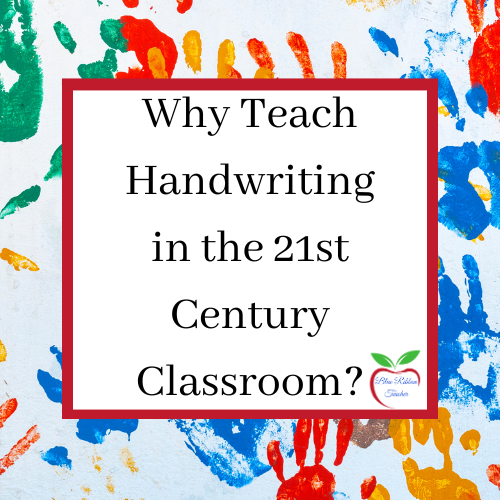Building Strong Foundations Through Handwriting
Why teach handwriting? In our digital age, where keyboards and touchscreens dominate our communication, handwriting might seem like an unnecessary skill in the twenty-first century. However, its importance to learning remains undeniable. From building strong foundations to fostering creativity and cognitive development, handwriting is a skill that goes far beyond simply putting pen to paper.
You may be thinking, why is teaching handwriting so important? I know there are people on both sides of the aisle . . students, parents, and even educators. However, when you consider the benefits of teaching handwriting, you’ll soon see why this is a necessary skill that needs to be taught . . . effectively.
So, Why Teach Handwriting?
Let’s consider a few questions.

Did you know teaching handwriting is a foundational literacy skill that has a direct impact on spelling, reading, and writing?
Did you know handwriting is more than just putting pen to paper?
Did you know that although 90% of educators feel teaching handwriting is important, only 12% said they received adequate training in teaching handwriting?
To this point, I can attest I did NOT learn how to teach handwriting in my K-8 education undergrad studies. NOR did my daughter who completed an early childhood and elementary education degree. As an adjunct professor, this topic is not in the program of studies in the College of Education.
Now, if 88% of teachers don’t feel they are effective at teaching handwriting, what further impact does this have on children’s developing foundational literacy skills? Could this be related to the literacy challenges children face today?
One thing we have learned in education is that handwriting does play a crucial role in children’s cognitive development. It also plays a key role in literacy achievement and overall communication skills.
In this article, I will delve into the benefits of handwriting for children and how it contributes to their language and literacy journey. Whether scribbling with crayons or forming letters and words, handwriting is an invaluable skill that should not be overlooked in today’s technology-driven world.
The Importance of Teaching Handwriting
Teaching handwriting is an essential skill for children to learn. Why? Handwriting gives us the opportunity to communicate in written form ~ writing words that share thoughts and information with others. This form of cognitive communication allows a person to connect with another person, question another’s ideas, and express new understandings.
Research has shown that writing things down by hand can enhance memory and comprehension. Therefore, making it an essential tool for learning and retaining information.
Handwriting Research
A recent study published in the journal, Frontiers in Psychology (2020), shares findings to suggest the delicate and precisely controlled movements involved in handwriting contribute to the brain’s activation patterns related to learning.

The physical act of writing engages multiple senses and neural pathways. Therefore, stimulating the brain in a way that typing does not.
Do you prefer to take notes during a class or write things down to remember information?
Would you rather put the information in the notes section of your phone?
In comparison to keyboarding, researchers continue to state, “We found no evidence of such activation patterns when using a keyboard” (Frontiers in Psychology, 2020). Yet more time is spent using the computer for literacy skill development, and handwriting is not being used effectively to develop this skill. Interesting, I may add, how much time do your students spend on the computer?
In another handwriting study published in Reading Research Quarterly (2021), when kindergarteners experienced a handwriting intervention incorporating repeated practice in recalling and reproducing letter forms, researchers found a statistically significant impact on early reading skills.
My friends, this is a handwriting “intervention”. Using a Multi-Tiered Support System (MTSS), this handwriting intervention should be daily instruction for all students (Tier 1). Instead, it is for those struggling students who need to develop foundational phonics skills (Tier 2 or 3). Wouldn’t all students benefit from this “intervention”?
Literacy Development Domains and Handwriting
Literacy development does not happen overnight. Yes, I know you understand this point. However, did you realize literacy development consistency occurs across four communication domains: listening, speaking, reading, and writing?
The first literacy skill children develop is listening, essentially beginning at birth, even in utero. When a baby is born, he/she has the capability to learn any language. Therefore, the language the baby hears most often is the sound connections being developed in the brain.

Language and literacy development play a crucial role in a child’s overall growth and success. It is the foundation upon which all other academic skills are built.
Strong language and literacy skills not only enable children to effectively communicate their thoughts and ideas (speaking and writing), but also empower them to become lifelong learners (listening and reading).
As children grow over the next couple of years, early childhood access to the first two literacy domains, listening and then speaking, are important to a child’s literacy development, if not a primary source to literacy success in reading and writing. Handwriting is the skill taught to bridge listening and speaking into the written form of reading and writing.
Handwriting’s Role in Literacy Development
Handwriting is more than just a means of transcribing words onto paper. It is a multi-sensory process that engages the brain in a unique way, facilitating language and literacy development.

When children write by hand, they activate multiple neural pathways. Those pathways are responsible for memory, language processing, and fine motor skills.
When students are ready to learn how to write symbols, that represent the sounds of the English language, it is important to use multi-sensory learning tasks and allow students a variety of options.
Research suggests that the physical act of writing by hand enhances comprehension and retention of information. When children write, they are encoding information into memory, actively engaging with material, leading to a deeper understanding of content. This is particularly beneficial when it comes to learning spelling, grammar rules, and vocabulary.
Handwriting and Cognitive Connections
Handwriting has been linked to various cognitive benefits that contribute to a child’s overall development. One such benefit is enhanced creativity. Related to the writing domain, when children write, they have the freedom to express themselves fluidly. This allows their thoughts and ideas to flow more naturally. This creative process stimulates the brain and encourages critical thinking and problem-solving skills.
Furthermore, handwriting improves cognitive functions such as memory and attention. The physical act of writing requires children to focus on the task at hand. The result leads to increased concentration and improved memory retention. Studies have shown students who take handwritten notes during lectures tend to perform better on exams compared to peers who type notes.
Handwriting and Fine Motor Skill Development
Handwriting plays a vital role in the development of fine motor skills. These skills are essential for everyday tasks such as buttoning clothes, tying shoelaces, and using utensils. When children write, they learn to control the movement of their fingers, hands, and wrists. They also refine their motor skills and hand-eye coordination.
Additionally, handwriting exercises the muscles in the hands and fingers, promoting strength and dexterity. These skills are crucial for legible handwriting and activities that require precision, such as drawing, painting, and playing musical instruments.
Although handwriting has many fine motor skills development, it is important to provide several opportunities for children to strengthen their hand muscles in order to develop stamina to allow for creativity to flourish. Learn more about teaching handwriting in my article: How to Teach Handwriting. I provide a variety of tips and strategies to support fine motor skill development.
Handwriting Enhances Reading and Comprehension Skills
Handwriting is closely connected to reading and comprehension skills
directly related to the reading domain.

When children write, they actively engage with the formation of letters and words, which helps them develop a deeper understanding of the written language. This process involves visual recognition, phonemic awareness, and the ability to decode and encode words.
Research suggests that children who practice handwriting alongside reading experience improved reading fluency and comprehension. The act of writing reinforces the connection between the visual representation of words and their meanings, making it easier for children to recognize and comprehend written text.
Handwriting vs. Typing: Which is Better for Learning?
At the beginning of this article, I addressed the conflict between the handwriting and digital twenty-first-century challenge. Therefore, we must now consider when each of these tools is appropriate for learning.

TYPING: In today’s technology-driven twenty-first-century world, typing has become the predominant method of writing thoughts. While typing offers its own advantages, it cannot replace the cognitive and physical benefits of handwriting. Typing may be faster, but it lacks the sensory and motor engagement that comes with putting pen to paper.
HANDWRITING: Handwriting allows children to develop fine motor skills, hand-eye coordination, and overall penmanship. It requires them to carefully
plan and execute the formation of letters and words, which strengthens their cognitive abilities. Handwriting does take more time and stamina compared to typing on a digital device. However, research suggests that handwriting activates different areas of the brain compared to typing, leading to improved learning outcomes.
So, when is typing appropriate in learning? Perhaps this tool is best used to express or publish learning; whereas, handwriting is the best tool to acquire learning.
Handwriting Resources
Related Resources to Teach Handwriting
How to Support Writers to Overcome Writer’s Block
How to Teach Writing Through Picture Composition
Overcome the Reading Comprehension Challenge
Final Thoughts: Why Teach Handwriting?
So, why teach handwriting? Handwriting is a skill that goes beyond the simple act of putting pen to paper. It plays a vital role in a child’s language and literacy development, fostering creativity, cognitive abilities, and fine motor skills.
By encouraging and supporting handwriting practice, parents and educators can ensure that children have a strong foundation for success in their language and literacy journey.
In a world dominated by technology, let’s not overlook the power of handwriting in shaping young minds. Handwriting is not just a way to write; it’s a way to learn, express, and create bridging the literacy domains: listening, speaking, reading, and writing.





